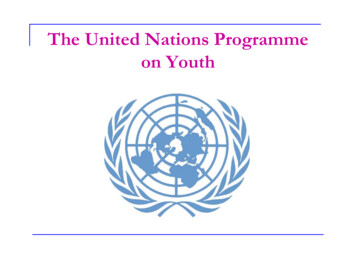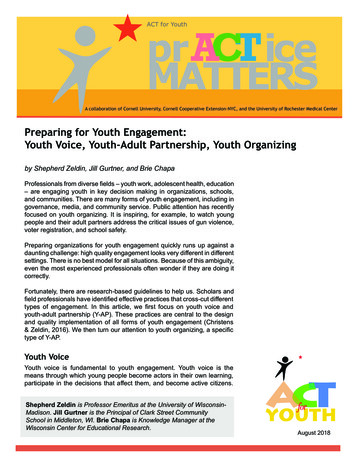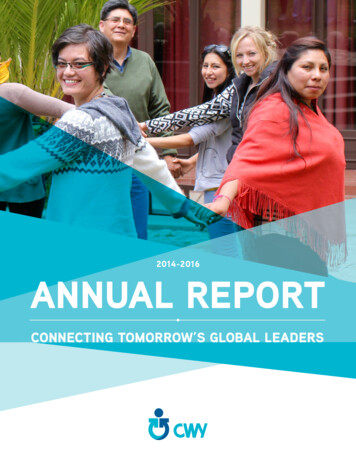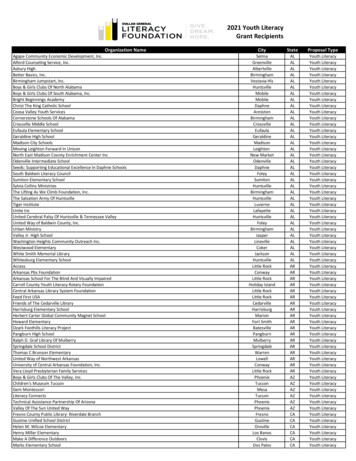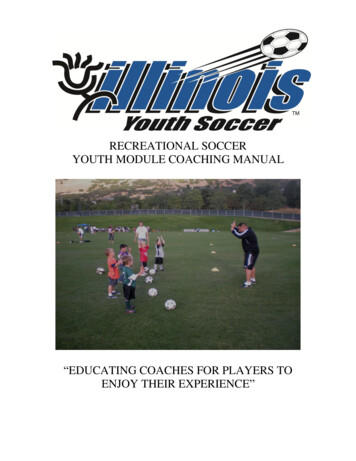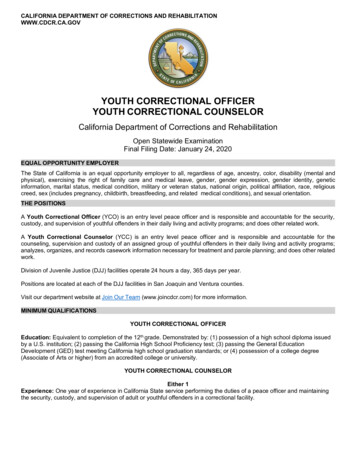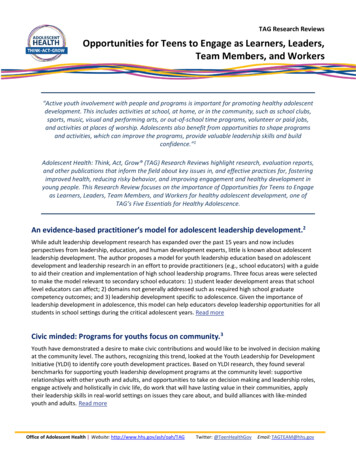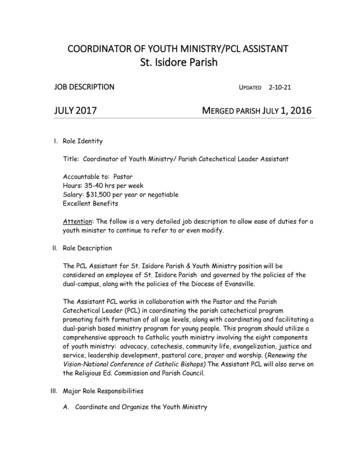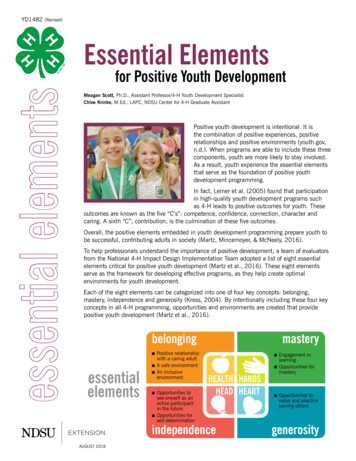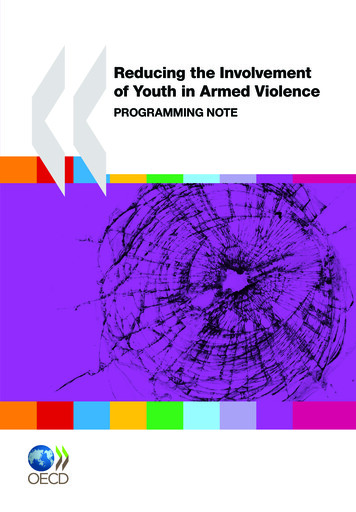
Transcription
Reducing the Involvementof Youth in Armed ViolenceProgramming note
Conflict and FragilityReducingthe Involvementof Youthin Armed ViolencePROGRAMMING NOTE
This work is published on the responsibility of the Secretary-General of the OECD.The opinions expressed and arguments employed herein do not necessarily reflectthe official views of the Organisation or of the governments of its member countries.Please cite this publication as:OECD (2011), Reducing the Involvement of Youth in Armed Violence: Programming Note, Conflictand Fragility, OECD -enISBN 978-92-64-10720-5 (PDF)Revised version (May 2011)For more details, please visit: ies: Conflict and FragilityISSN 2074-3637 (online)Photo credits: Cover Franco Bosetti/Dreamstime.com.Corrigenda to OECD publications may be found on line at: www.oecd.org/publishing/corrigenda. OECD 2011You can copy, download or print OECD content for your own use, and you can include excerpts from OECDpublications, databases and multimedia products in your own documents, presentations, blogs, websites andteaching materials, provided that suitable acknowledgment of OECD as source and copyright owner is given.All requests for public or commercial use and translation rights should be submitted to rights@oecd.org.Requests for permission to photocopy portions of this material for public or commercial use shall be addresseddirectly to the Copyright Clearance Center (CCC) at info@copyright.com or the Centre français d’exploitation dudroit de copie (CFC) at contact@cfcopies.com.
Foreword – 3ForewordArmed violence is an everyday reality for millions of people around theglobe. More than 700 000 people die as a result of armed violence each year.Many more experience traumatic loss in their families and are left with lasting psychological and physical scars. The impact of armed violence extendsfurther, negatively influencing development, peace and good governance,often by creating a climate of impunity, corruption and by underminingpublic institutions. It is also closely tied with transnational crime and themisery and abuse associated with the illegal trafficking of arms, drugs andpeople. Finally, the economic impact of armed violence is striking with thecost of lost productivity due to non-conflict armed violence alone estimatedto cost upwards of USD 95 billion annually worldwide. This violence hasimportant youth and gender dimensions. The majority of perpetrators andvictims are men, while women and girls are at greater risk of violence that isless visible and committed in the private sphere, including intimate partnerviolence, child abuse, sexual and gender based violence. Measures at reducing armed violence are therefore also measures at reducing human suffering.The OECD DAC policy paper Armed Violence Reduction: EnablingDevelopment, published in 2009, acknowledged as a challenge the increasedlevels of armed violence in non-conflict countries, the increasing linkagebetween conflict and crime, rapidly growing youth populations in the southand accelerating levels of unregulated urbanisation. The paper provided amethodology to help donors tackle the programming challenging of reducingarmed violence. Building on the OECD DAC policy paper, three programming notes were developed to contribute to our understanding of specifictypes of armed violence: Youth and armed violence, armed violence inurban areas and Security System Reform in relation to Armed violencereduction. Each note aims to improve our understanding of these dynamicswhile also offering practical assistance on assessments, programme design,risk management, monitoring and evaluation, as well as on entry points fordirect and indirect programming.2011 is an important year for global efforts at Armed violence reduction with a series of regional best practice seminars as well as the high-levelReducing the Involvement of Youth in Armed Violence: Programming Note – OECD 2011
4 – Forewordconference on Armed violence reduction in the context of the Geneva declaration on armed violence and development, scheduled for October 2011. Istrongly encourage the use of these programming notes to strengthen ourunderstanding of these critical development issues and to support new innovative programmatic guidelines for Armed violence reduction.Jordan RyanAssistant Administrator andDirector, Bureau for Crisis Prevention and RecoveryUnited Nations Development ProgrammeReducing the Involvement of Youth in Armed Violence: Programming Note – OECD 2011
Acknowledgements – 5AcknowledgementsThis programming note was prepared for the International Network onConflict and Fragility (INCAF) of the Development Assistance Committee(DAC) of the Organization for Economic Co-operation and Development(OECD). The programming note was researched and drafted by PeggyOchandarena and Lyndsay McLean Hilker through the Security SystemReform Project. It was funded by the United States Agency for InternationalDevelopment (USAID) and the German Federal Ministry for EconomicCooperation and Development (BMZ). A range of experts contributedto drafting the note, including members of the INCAF Armed ViolenceReduction (AVR) advisory panel who provided insightful feedback during thecourse of this paper’s conceptual development and editorial review. Specialrecognition is owed to the following individuals for their input: Julie Werbeland Joan Hoffman, and to Charlene Seligman and Sanida Kikic for researchefforts. Final thanks go to the secretariat of the OECD DAC’s InternationalNetwork on Conflict and Fragility (INCAF) for guidance and practical assistance, in particular Rory Keane, Erwin van Veen, Sarah Cramer and JoshuaRogers.Reducing the Involvement of Youth in Armed Violence: Programming Note – OECD 2011
Table of contents – 7Table of contentsList of abbreviations 9OECD Armed Violence Reduction (AVR) programming notes 111. The links between youth and armed violence 13Youth armed violence: Trends 15Factors that put youth at risk of engaging in armed violence 17Factors that prevent youth from engaging in armed violence 192. Assessments 21Assessment and analysis: Key approaches 21Assessment tools 233. Programming 27The role of donors 27Entry points for programming 28Programming approaches 31Direct programme interventions 32Indirect programme interventions 334. Specific interventions 37Supporting parents 37Supporting youth participation in the society and economy 38Supporting and enforcing youth rights 41Supporting and keeping the peace 41Managing risks 455. Monitoring and evaluation 47Data collection 47Performance indicator development 49Reducing the Involvement of Youth in Armed Violence: Programming Note – OECD 2011
8 – Table of contents6. Conclusions and recommendations 51General lessons 51Lessons for programme design 52Lessons for programme implementation 53Notes 57Bibliography 59FigureFigure 3.1 Differing levels of youth engagement with violent groups 33TableTable 3.1 The armed violence reduction framework and programme initiatives 28BoxesYouth: An important segment of the population 13Box 1.1Box 1.2 The Armed Violence Reduction (AVR) framework applied to youth 14Box 1.3 Child soldiers 15Box 2.1 Gender issues and considerations 22Box 2.2 West Bank Gaza: Palestinian Youth Empowerment Programme (Ruwwad) 24Box 3.1 Tajikistan: The Juvenile Justice Alternatives Project (JJAP) 30Box 3.2 Systemic prevention of youth violence: A GTZ handbook to design andplan comprehensive violence prevention measures 34Box 3.3 Youth targeted interventions 35Box 4.1 Supporting parents 38Box 4.2 Creating structures for youth participation in Bosnia and Herzegovina 39Box 4.3 Youth empowerment and employment in Kenya 40Box 4.4 Community issues 41Box 4.5 Establishing family and child protection units in police stations inNorthern Sudan 42Box 4.6 Examples of DDR programmes 43Box 4.7 Conflict prevention for youth and their communities in Guinea 44Box 4.8 Reforming juvenile justice systems: UNICEF examples from aroundthe world 45Box 4.9 Understanding risks 46Box 5.1 The Inter-American observatory on security 48Box 5.2 Juvenile justice system indicators 49Box 6.1 Multi-sector programming 53Box 6.2 Youth training 55Reducing the Involvement of Youth in Armed Violence: Programming Note – OECD 2011
Abbreviations – 9List of abbreviationsAVRArmed violence reductionDAC OECD Development Assistance CommitteeDDR Disarmament, demobilisation and reintegrationGTZDeutsche Gesellschaft für Technische Zusammenarbeit(German Society for Technical Co-operation)INCAF International Network on Conflict and FragilityJJAPJuvenile Justice Alternatives Project in TajikistanNGO Non-governmental organisationSSRSecurity system reformUNCRC United Nations Convention on the Rights of the ChildUNESCO United Nations Educational, Scientific and CulturalOrganizationUNICEF United Nations Children’s FundUNODC United Nations Office on Drugs and CrimeUSAID United States Agency for International DevelopmentReducing the Involvement of Youth in Armed Violence: Programming Note – OECD 2011
OECD Armed Violence Reduction (AVR) programming notes – 11OECD Armed Violence Reduction (AVR)programming notesApproximately 740 000 people die as a result of armed violence eachyear. Armed violence erodes governance and peace whilst slowing downachievement of the Millennium Development Goals (MDGs). It can have assignificant an effect on security and development in settings of chronic violent crime and inter-personal violence as it can in societies affected by waror civil conflict. An armed violence agenda therefore includes a wide rangeof countries, cities and citizens whose development and security are underthreat. It refers to the use or threatened use of weapons to inflict injury, deathor psychosocial harm.To help desk officers and conflict/fragility experts who are working to tacklethe problem of armed violence, OECD Development Assistance Committee(DAC) members have requested three Armed Violence Reduction (AVR)Programming Notes to build on the OECD DAC policy paper on Armed ViolenceReduction: Enabling Development (OECD, 2009). The three notes cover: Armed violence in urban areas: The majority of the world’s population now lives in urban centres. As economic transformations accelerate rural-urban migration, the rural poor are being converted intoan urban poor who populate mega-slums on the periphery of majorurban centres. More and more of these areas are afflicted by highlevels of armed violence. Youth and armed violence: The largest-ever generation of youngpeople is now entering adulthood. Almost half of the world’s population is under the age of 24 and the vast majority of 10-24-year-oldslive in less developed countries. Youth are particularly at risk ofbeing exposed to and engaging in armed violence and crime. AVR and security system reform (SSR): AVR and SSR have similarobjectives and are mutually reinforcing. But they also have their distinct methods, entry points and comparative advantages. It is importantto understand the linkages between the two approaches in order tomaximise the impact of public safety and security interventions.Reducing the Involvement of Youth in Armed Violence: Programming Note – OECD 2011
12 – OECD Armed Violence Reduction (AVR) programming notesTo ensure an effective response to armed violence, the programmingnotes use an armed violence “lens”, which was developed in Armed ViolenceReduction: Enabling Development. The lens helps practitioners consider thekey elements shaping armed violence patterns. These include the peopleaffected by armed violence, the perpetrators and their motivations, the availability of instruments (arms) and the wider institutional/cultural environment that enables and/or protects against armed violence. The lens highlightsrisk factors associated with armed violence and their vertical linkages from thelocal to the global level. It encourages practitioners to think outside specificsector mandates and provides practical entry points for AVR programming.Armed violence prevention and reduction are feasible but require significant leadership by affected states and investment of financial resources bydevelopment partners. They also require the ability to engage with non-stateand sub-national actors. Finally, effective interventions need a good evidencebase, participatory assessments and the simultaneous engagement in multiplesectors (reflecting the broad range of interrelated issues and actors involved),at multiple levels (local, national, regional and global) and over a longer timehorizon.Reducing the Involvement of Youth in Armed Violence: Programming Note – OECD 2011
1. The links between youth and armed violence – 13Chapter 1The links between youth and armed violenceIt is critical that donors focus on youth because they are the largest andpotentially most significant population in the developing world; approximately1.3 billion youth live in developing countries (World Bank, 2007; Box 1.1).Rather than using a rigid construct based on age, this programming notedefines youth as those people in the transitional stage between childhoodand adulthood.1 The majority lack basic education, marketable skills, decentemployment and opportunities for positive engagement in their communities.While most youth do not engage in significant or repeated acts of violence,evidence suggests that out-of-school and un- or underemployed youth are atgreater risk of becoming perpetrators – and victims – of violence and crime,along with youth who suffer from economic and social deprivation, marginalisation, neglect and abuse (Social Development Direct, 2009). Such negativeoutcomes have costs for the individuals themselves, as well as their families,communities, society and the economy. On the other hand, when their energiesand skills are supported and channelled productively, youth can be a powerfulforce for constructive change.This programming note builds on the recent OECD publication, ArmedViolence Reduction: Enabling Development (OECD, 2009) and applies theframework it presents specifically to youth armed violence (Box 1.2).2 Thatframework describes the key elements that shape armed violence patterns:Box 1.1. Youth: An important segment of the populationIn Afghanistan, 68% of the population is under 25; in the Palestinian Territories,67% of the population is under 24 (World Bank, 2007). At the end of the SierraLeone civil war in 2002, 63% of the population was under 25 (IRIN, 2007). InWest Africa, 40% of the population is less than 15 years old.Source: Florquin and Berman, 2005.Reducing the Involvement of Youth in Armed Violence: Programming Note – OECD 2011
14 – 1. The links between youth and armed violencethe people affected by armed violence, the perpetrators and their motivations, the availability of instruments and the wider institutional/culturalenvironments that enable or protect against armed violence. It encouragesBox 1.2. The Armed Violence Reduction (AVR) framework applied to youthThe AVR framework takes into consideration the main elements shaping armed violence patterns: The people affected by armed violence – the victims, communities and societies thatsuffer. Evidence shows that youth who are witnesses and victims of violence at familyand community levels and during armed conflicts can become conditioned to regardviolence as an acceptable means to resolve problems. This can increase the likelihoodthat they will be future perpetrators. The perpetrators of armed violence, their motives, and the ways in which they areorganised. Violent youth tend to commit a range of crimes and exhibit a range of riskybehaviours. Youth may not always be willing perpetrators of violence but engage inviolence due to external pressures, including peer pressures and negative social norms,perceptions and practices. The instruments of armed violence, focusing on an analysis of how arms are integratedinto a community’s socio-economic, cultural, and political fabric. The widespreadavailability of weapons does not cause armed violence, but is a risk factor, with youthviewing weapons as sources of protection and status. The increasing availability ofsmall arms, which are used in about 60% of all homicides, and their ease in handling,makes them accessible to even young children. The institutions, including both the formal and informal, which regulate and controlthe use of armed violence. Formal institutions focus on capacities and deficits in thepublic security and justice, education, and health sectors as well as broader problemsof governance, service delivery, and social protection. Informal institutions focus onsocial and cultural factors, including culturally-accepted norms that facilitate or prohibit the use of armed violence, as well as community-based organisations that are partof and affect the social fabric. The AVR lens includes four levels of engagement: the local, national, regional andglobal. Examples of youth armed violence at these levels include: Local: Central American neighbourhood gang warfare. National: youth used to create fear and intimidation by politicians in Zimbabwe and Kenya. Regional: cross-border militias in Africa’s Great Lakes region that include youth fromfour countries. Global: Muslim youth drawn into global jihad extremist movements.Source: OECD, 2009.Reducing the Involvement of Youth in Armed Violence: Programming Note – OECD 2011
1. The links between youth and armed violence – 15practitioners to think outside of specific programming mandates and offers ashared analysis that can bring together a diverse array of actors who work ondifferent aspects of armed violence, even if they are not working in tandem.This note also outlines how development agencies should target interventions to prevent and reduce youth armed violence. It covers characteristics ofyouth armed violence, assessments, entry points for programming, programming options by sector, risk management, monitoring and evaluation. It takesa holistic approach to youth armed violence, recognising that in practice,similar developmental factors underlie youth engagement in violence, regardless of the context. Youth armed violence occurs in multiple contexts such aswithin relationships or in the course of criminal activity.This note emphasises the importance of providing constructive alternatives to violent groups and ideologies. Extensive research has been done onyouth violence stemming from biological, psychological and family risk factors (WHO, 2002; Social Development Direct, 2009). A key conclusion is thatintervention at infant and early childhood stages is critical. The most effectiveprogramming would include preventative strategies alongside programmes toaddress current issues.Youth armed violence: TrendsChildren and youth are increasingly growing up in cultures where armedviolence is a norm within families, communities, or states. Trends in contemporary conflict affecting youth include the increasing proximity of violenceto the lives of young people and the eroding of boundaries between differentkinds of violence (UNICEF, 2007a). Young people in the developing world areliving in environments in which firearms are cheap, poorly regulated, widelycirculated and often traded illicitly, increasing armed violence and hinderingpeace building and humanitarian assistance. These weapons are easy for youthto learn to use and to carry; for example, more than 90% of young peopleBox 1.3. Child soldiersThere are an estimated 300 000 child soldiers under the age of 18 engaged inmore than 33 conflicts around the world. Boys and girls are used as combatants, messengers, porters and cooks and for forced sexual services. Some areabducted or forcibly recruited; others are driven to join by poverty, abuse anddiscrimination, or to seek revenge for violence enacted against them or theirfamilies.Source: UNICEF, 2007a.Reducing the Involvement of Youth in Armed Violence: Programming Note – OECD 2011
16 – 1. The links between youth and armed violenceinvolved in conflict in a variety of roles in Liberia, Guinea and Sierra Leonehad access to weapons (Florquin and Berman, 2005). The increasing familiarity of youth with small arms and their proliferation can sustain a culture ofinterpersonal and gang-related violence in stable societies that are “at peace”,as well as in fragile and post-conflict societies, where the easy access to gunshas the potential to help trigger or reignite conflict.Today’s armed groups are often non-state actors using non-traditionalforms of warfare to fight internal rather than inter-state conflicts. Frequently,they adopt strategies that bring the battle more immediately to the civilianpopulation and into the lives of millions of youth (Box 1.3). A state’s use ofparamilitary and proxy forces increases youth vulnerability because theseforces are less accountable to government and the public. Youth are increasingly used as perpetrators or accomplices in terrorist acts and in some placeshave increasingly come under suspicion and suffer severe abuses whendetained. Motivations and actions of violent groups fluctuate between criminal, ideological and political such that clear lines can be difficult to draw. Forexample, armed conflict that began over political grievances can be furtheredby opportunistic greed. Mischaracterising violent groups can exclude themfrom conflict resolution dialogue and demobilisation (UNICEF, 2007a).The result of the realities described above is that young people are ofteninvolved in armed violence simultaneously as perpetrators, victims and witnesses. Young people are frequently the victims of violence – boys and youngmen are most at risk of conflict-related death and homicide; girls and youngwomen are increasingly at risk of sexual violence, especially in situations ofarmed conflict. Youth homicide and non-fatal violence not only contributegreatly to the global burden of premature death, injury and disability, but alsohave a serious, sometimes lifelong, impact on behaviour and psychologicaland social functioning, and affect victims’ families, friends and communities.Violence involving young people adds greatly to the costs of health and welfare services, reduces productivity, decreases the value of property, disruptsessential services and undermines the fabric of society (WHO, 2004).Policy makers and practitioners have tended to conduct separate analysisfor different forms of collective violence – political, criminal and ideological– in which youth are involved. A close examination of the evidence suggeststhat the underlying psychological factors that influence voluntary youth participation in different types of violent groups are similar, despite the different contexts in which youth participate. For example, youth living in LatinAmerica may be motivated to join a gang for the same reasons that youth inAfrica join armed groups as child soldiers. The developmental tasks of adolescence include solidifying a set of values that guide behaviour, respondingmore to their peers than adults, achieving independence from adults emotionally and financially, and becoming members of the community (Erikson,Reducing the Involvement of Youth in Armed Violence: Programming Note – OECD 2011
1. The links between youth and armed violence – 171968). Coming of age in conflict environments makes it particularly difficultfor young people to complete this transition as community structures andstate functions such as health care and education are disrupted. For marginalised young people, violent groups seemingly offer a fast transition toadulthood as well as protection and opportunities for economic advancementand adventure. These groups also provide a sense of identity and affinity, cultivate respect or status among peers and the community, or allow for revengeon other groups. The type of group joined is more a result of proximity,opportunity and familiarity than a reflection of fundamental differences inthe psychological motivations of young people. While men are predominantlyinvolved in armed violence, women are increasingly involved – not just insupport roles, but also in perpetrating acts of violence themselves.Factors that put youth at risk of engaging in armed violenceRisk factors for youth armed violence are the conditions that increase thepossibility of a young person becoming a victim or perpetrator of violence.Preventing violence involves direct efforts to remove or reduce risk factors,as well as harnessing the indirect effects of other policies and programmesthat may reduce exposure to underlying causes and risk factors. No singlefactor explains why a person or group is at high or low risk of such violence.Instead, violence is an outcome of interaction among risk factors at fourlevels: individual (including biological factors), relationship, community andsocietal (WHO, 2002). The following risk factors for youth violence havebeen documented in a variety of socially and culturally-distinct settings:Individual factors: traits such as hyperactivity, impulsiveness, poor behavioural control and attention problems; a history of early aggressive behaviour;early involvement with drugs, alcohol and tobacco; antisocial beliefs andattitudes; low intelligence; low commitment to school and school failure; andexposure to violence and conflict in the family. Additionally, studies show thatdrunkenness is an important immediate situational factor that can precipitateviolence. Relationship factors: these refer to family, friend, intimate partnerand peer relationships, and include poor parental supervision of children; harsh or inconsistent disciplinary practices; witnessing violenceor experiencing abuse as a child; low levels of attachment betweenparents and children; low parental involvement in children’s activities; parental alcohol/substance abuse or criminality; experiencingparental separation or divorce at a young age; poor family functioning; coming from a single-parent household; and low socio-economicstatus of the household. Associating with delinquent peers is also animportant risk factor for youth violence.Reducing the Involvement of Youth in Armed Violence: Programming Note – OECD 2011
18 – 1. The links between youth and armed violence Community factors: high residential mobility; high unemployment;high population d
tion now lives in urban centres. As economic transformations accel-erate rural-urban migration, the rural poor are being converted into an urban poor who populate mega-slums on the periphery of major urban centres. more and more of these areas are afflicted by high levels of armed violence.



